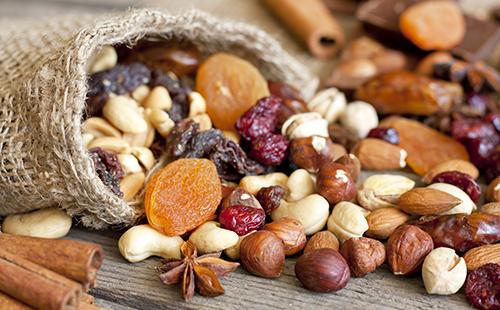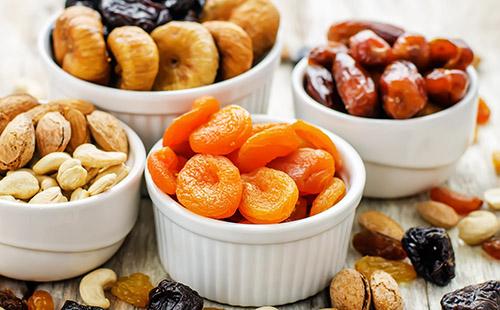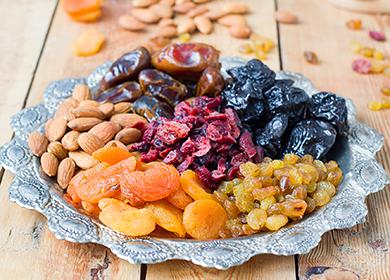The content of the article
Apples, melons, bananas, plums, apricots - drying from these and many other fruits is easy to do yourself. But there is not always enough time for this, so more often we still buy a finished product. It is important to understand that on an industrial scale, fruit blanks are made using special technologies. This speeds up and simplifies processing, but affects the quality and shelf life of dried fruits.
Features of drying. How much to store it
For comparison, here's how various drying methods affect the final product:
- in the shadow - This is a long, but ideal way, when the water from the fruits evaporates gradually and evenly;
- in the sun - fruits dry faster, but not all nutrients like heat (for example, vitamins A and C with this method are partially lost);
- industrial furnaces - forced drying kills half of the trace elements and vitamins.
The following table describes the external characteristics of products that are dried correctly.
Table - How to determine the "good" dried fruits by external signs
| Product | Characteristic |
|---|---|
| Black raisins | - Blue-black; - matte |
| Kishmish | - brown; - matte |
| Dried apricots and apricot | - Brown (sometimes grayish); - no shine |
| Prunes | - The black; - matte - opaque; - wrinkled |
| Pears, apples | - tan |
| Bananas | - Dark brown; - matte |
| Figs | - Flattened; - gray or beige; - white plaque possible |
| Cranberry | - maroon; - no shine |
| Cherry | - Brownish burgundy; - no shine |
Which product is not worth buying
Choosing between a beautiful orange apricot and gray faded apricots, it is difficult to listen to the voice of reason - fruits that have undergone pre-sale preparation are too tempting. Nevertheless, whenever your hand reaches for a delicious shiny prune or bright red cherry, remember - unnatural beauty is dangerous. How do manufacturers achieve these external product characteristics?
- Dyeing. Amber or orange dried apricots can be tinted with harmless curcumin or treated with riboflavin phosphate, toxic alkanine and tartazin. It is impossible to distinguish by eye how the fruits acquired a bright color.
- Soaking. If, for example, deep cracks are visible on figs, this is a sign that the product has been soaked in caustic soda.
- Wiping. A gloss of dried fruit may not be natural. Moisture evaporates, and manufacturers restore beauty with glycerin or soybean oil with trans fats.
- Smoke treatment. If dried apricots or prunes have a sharp “smoked” aroma, they applied “liquid smoke”, famous for its carcinogens.
How to preserve dried fruits: preparation, choice of place and container
“Where to store dried fruits at home?” Is the first question that arises after purchase. Ideally, the dryer should be placed in a well-ventilated dark place with air humidity up to 65-75% and a temperature of 2-10 ° C. It is difficult to create such conditions in the apartment, so choose a place in which it is as dark and dry as possible. Perhaps it will be a distant kitchen cabinet or pantry. It is important that there are no stoves or heating radiators near. To regulate humidity in a chosen place, wrap salt or rice in a cloth and place the sorbent on shelves with dried fruits.

Preliminary processing
To keep dried fruits longer, immediately after purchase, open the bag and carry out quality control: fruits suitable for long storage do not stick together if you squeeze them in your hand. But that's not all. The following manipulations will extend the shelf life.
- Little baby. Select the wet fruits, lay them on a layer of paper and dry in the shade in the yard or without access to light in the apartment.
- Prevention of mold and insects. Dried dried fruits additionally warm in the oven at 60-80 ° C for an hour and a half.
- The neutralization of "dyes". If you bought bright fruits processed with greases and dyes, the product will have to be soaked for a couple of hours in cool water. So you partially get rid of the internal "chemistry" and wash off the surface of glycerin and oil. After this, the dried fruits should be dried and warmed in the oven.
Temperature
Sour fruits in conditions of low humidity are stored longer than sweet and fleshy fruits. This is explained by the fact that water and sugar are a favorable environment for the development of mold and microbes, rendering food products unusable.
The ideal temperature for dried fruits is not higher than 10 ° C. When the thermometer column shows above 17 ° C, all chemical processes are accelerated, and dried fruits deteriorate faster. The following table will help determine the optimal storage temperature for your dried fruit.
Table - Shelf life of dried fruits and dried berries at different temperatures (humidity 65-75%)
| Dried fruits | 2-10 ° C | 10-17 ° C | 18-24 ° C |
|---|---|---|---|
| Raisins | 18 months | 12 months | 6 months |
| Dried apricots, apricot, prunes | 12 months | 6 months | 3 months |
| Apples, pears | 18 months | 12 months | 6 months |
| Bananas, figs, dates | 10 months | 6 months | 3 months |
| Cranberries | 18 months | 12 months | 10 months |
| Dogrose | 3 years | 18 months | 12 months |
At a constant temperature of up to −20 ° С (in the freezer), the shelf life is almost unlimited if the fruits are not thawed.

Suitable containers
It is simple and convenient to store the dryer in bags made of polyethylene, but with this method there is no guarantee that pests will not get under the film. There are more reliable ways.
- Glass jars. Or plastic food trays. So basically store very dry and non-sticky fruits, such as drying from apples, cherries or rose hips. It is important that the containers close tightly. Check the contents of the cans periodically to ensure that mold or bugs are not missed.
- Paper bags or canvas bags. These are suitable for almost all fruits.Before using fabric bags, it is recommended to further process them: soak them in a strong saline solution (100 g per one and a half liters of water). Then, without rinsing, dry well. The salt accumulated in the fibers will stop insects and regulate the moisture inside the bag.
- Vacuum bags. In a vacuum, any dried fruit feels great, but for "sticky" ones (prunes, melons, figs) - this is the best option.
Insect protection
If you find bugs in a jar or bag with a dryer, do not rush to throw away everything at once. Perhaps the insects have not yet had time to breed. Sort and warm the intact fruits for an hour at 80 ° C. A small household tricks will help protect dried fruits from moths and other insects:
- mint - put on the bottom of the container for storing drying parchment and a few leaves of dry mint;
- vinegar - before use, rinse the jars with a solution of vinegar and water (1: 2), dry without rinsing;
- zest - insects do not like the smell of lemon, mandarin, orange and do not attack dried citrus fruits, so put zest on a shelf with dried fruits (change the skins once a month).
Tips for storing "moody" fruits
Low moisture dried fruits such as apples, quinces or pears are stored without problems. It is more difficult to prevent the spoiling of juicy fruits, which, even after drying, retain a rather high humidity. For such fruits, consider some recommendations.
- Prunes. Well-drained plums up to three months are stored in a dark place at a temperature of even about 20 ° C. But if the house is too warm, it is better to store prunes in the freezer. Keep the product in paper, vacuum or in a container of glass (plastic).
- Dried apricots, apricot. It is easier to store dried apricots at home, as they are usually well dried. Put dried apricots in a closed container or in a linen bag, and send to a dark place. But if you store apricots in cloth packaging for a long time, they will dry out and cover with a white coating. You can extend the shelf life by freezing: this is how dried apricots last up to two years. Before eating, the fruit is thawed at room temperature.
- Raisins. Still, it is better to store raisins without a refrigerator. The product loves the air, so sort out the dried berries and pour into a cotton bag. Glass or plastic containers are covered with paper, not tight lids, and placed in a dry and cool place. Sprinkle dried raisins before use with water and warm for a minute in a microwave.
- Dates and Figs. Such fruits are poorly stored at room temperature. To make a reserve for the winter, put the sweet dryer in a jar with a lid or in a vacuum container and place on the shelf of the refrigerator. At temperatures up to 5 ° C, the fruits will not lose their taste and useful properties for several months. You cannot store these fruits in ordinary plastic bags. Before wintering, dried figs and dates are not washed.
The question of how to properly store dried fruits is most relevant if you have your own garden and you yourself procure drying in large quantities. In other cases, it makes no sense to buy a product for future use - dried fruit is sold in stores all year round, and healthy dessert can be purchased at any time.

